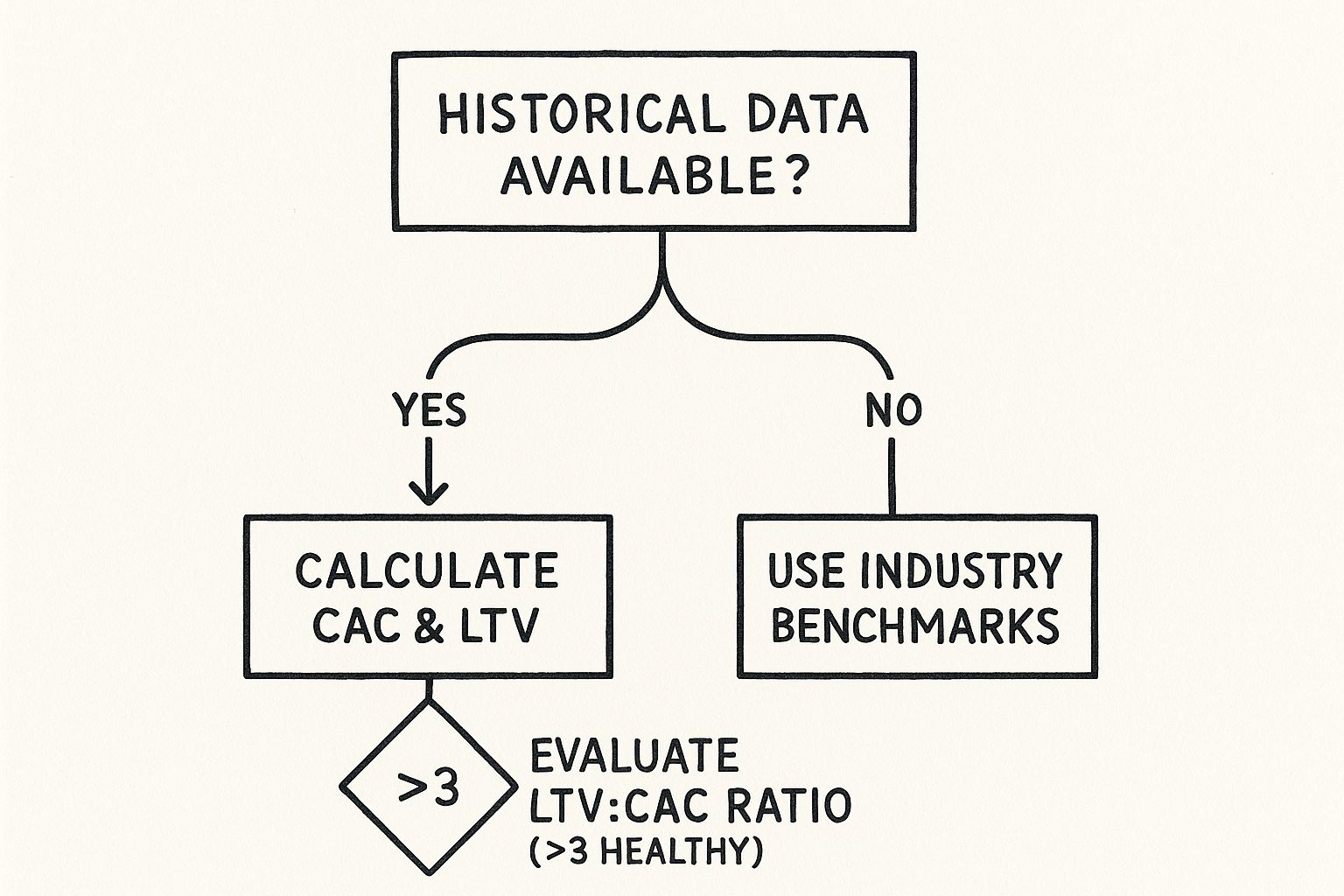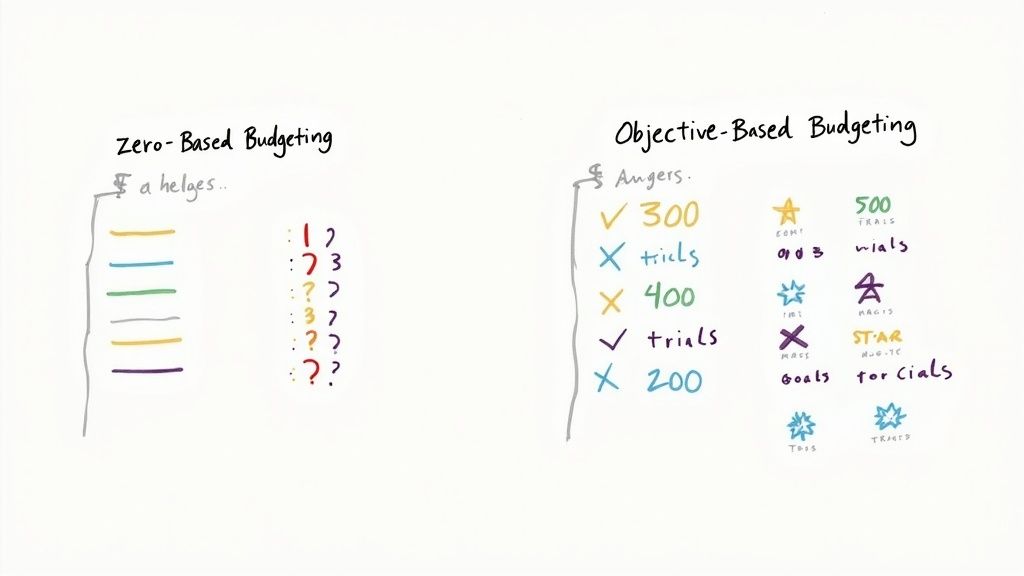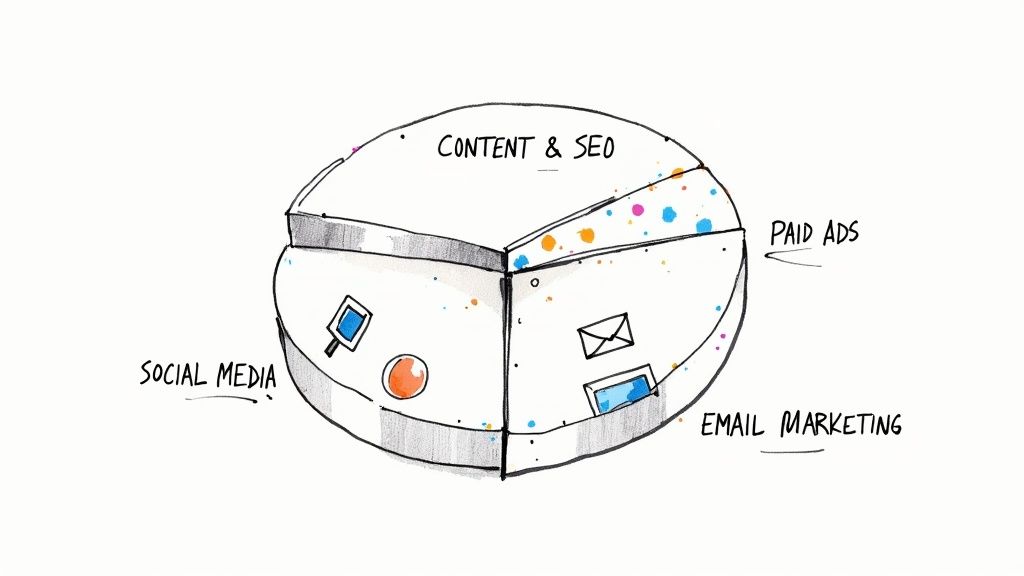Marketing Budget for Startups: Your No-BS Spending Guide
Your marketing budget isn't just a number on a spreadsheet—it's the fuel for your growth engine. It’s the battle plan that turns every dollar into new customers and real revenue. Without it, you're just guessing.
Your Budget Is Your Battle Plan—Don't Go to War Without It

Treating marketing as an afterthought is the fastest way to burn cash. Without a plan, your budget becomes a slush fund for shiny objects instead of a tool for sustainable growth.
A solid budget forces you to answer the hard questions upfront. Who are we trying to reach? Where do they hang out? Which channels give us the most bang for our buck? This isn't about restriction; it's about empowerment. A clear budget gives your team the confidence to execute, knowing every action is tied to a winning strategy.
The High Cost of Guessing Games
"Winging it" is an expensive habit. Operating without a budget invites chaos. Resources get dumped into dead-end channels, and you miss huge opportunities because you can't act fast.
The pitfalls are predictable and painful:
Wasted Ad Spend: Pouring money into Google or Facebook ads without clear KPIs is like playing roulette with your runway.
Inconsistent Branding: Random acts of marketing create a disjointed message that confuses customers and weakens your market position.
Team Misalignment: Without a shared financial blueprint, sales and marketing teams work against each other, creating friction and killing deals.
A budget transforms marketing from a cost center into a predictable, measurable growth driver. It builds accountability and gives you a framework to know what’s working—and what to kill.
A budget gives your money a mission. It ensures every dollar is actively working to acquire customers, build your brand, and drive your startup forward.
How to Navigate Today’s Financial Pressures
Let's be real—the current economy puts every dollar under a microscope. While marketing is shifting to digital-first tactics, a staggering 59% of CMOs feel their budgets are holding them back. Efficient spending is no longer optional.
This pressure makes a well-defined marketing budget non-negotiable. To build your foundation, grab a startup marketing plan template. Use it to articulate your goals and map your financial strategy directly to them. This planning is your first step toward building a marketing function that thrives in any economy.
Startup Marketing Budget Benchmarks at a Glance
So, how much should you spend? There's no magic number, but these benchmarks offer a starting point based on your startup's stage.
Startup Stage | Revenue Status | Typical Marketing Spend (% of Revenue) |
|---|---|---|
Pre-Seed/Seed | Pre-Revenue | Focus on one-off launch costs, lean experiments. No % rule applies. |
Early-Stage | Post-Revenue, <$5M ARR | 20-30% (Aggressive growth, brand building) |
Growth-Stage | $5M-$50M ARR | 15-25% (Scaling proven channels, market expansion) |
Mature/Scale-Up | $50M+ ARR | 10-15% (Brand maintenance, optimization, efficiency) |
Remember, these are just benchmarks. A B2C company burning cash for user acquisition will have a vastly different budget than a bootstrapped B2B SaaS focused on profitable growth. Use this table to get your bearings, but let your specific goals and business model dictate your spend.
Defining Your Core Financial Metrics
Before you spend a single dollar, get a grip on your business economics. A marketing budget for startups isn't about spending; it's about making calculated investments in growth. Anchor every decision in cold, hard numbers.
This means ditching gut feelings for the two most critical metrics in your playbook: Customer Acquisition Cost (CAC) and Customer Lifetime Value (LTV). These aren't just jargon—they're the foundation of a business built to last.
Understanding Customer Acquisition Cost
Your Customer Acquisition Cost (CAC) is what you pay to land one new customer. It’s the total sales and marketing spend required to get someone to click "buy." To understand your ROI, start here: What Is Customer Acquisition Cost (CAC) Explained.
The formula is simple: divide your total sales and marketing costs by the number of new customers acquired in that same period.
Example: Your B2B SaaS startup spent $5,000 on marketing last month. You landed 50 new customers. Your CAC is $100. That one number tells you exactly what it costs to grow.
Knowing your CAC is the first step to building a predictable growth machine. For a deeper dive, our guide on customer acquisition cost calculation breaks down the formula.
The Power of Customer Lifetime Value
Now for the other side of the coin: Customer Lifetime Value (LTV). This is the total revenue you can expect from a single customer over their entire relationship with you.
LTV gives your CAC context. A $100 CAC might seem high, but if that customer pays you $1,500 over the next two years, it's a brilliant investment. Conversely, a $20 CAC is a disaster if customers only pay you $15 before they churn.
Calculating LTV can be tricky when you're new, but here’s a simple formula to start:
(Average Purchase Value) x (Average Purchase Frequency) x (Average Customer Lifespan)
This metric reveals what a customer is worth long-term, not just today. It's the key to making smart, forward-thinking budget decisions.
Your Ultimate Health Check: The LTV to CAC Ratio
The real magic happens when you bring these metrics together. The LTV:CAC ratio is the ultimate health check for your business. It tells you if you're building a sustainable company or just burning cash.
A healthy ratio is 3:1 or higher. For every dollar you spend, you should get at least three back.
1:1 Ratio: You're losing money. Red flag.
3:1 Ratio: You've got a solid business model. This is the sweet spot.
5:1+ Ratio: You're crushing it. It might be time to invest more aggressively to grow even faster.
This simple ratio cuts through the noise and tells you if your marketing is actually making you money.
The LTV:CAC ratio is your north star for budget allocation. It shows you which channels deliver profitable customers and where to double down.
What If You Have No Data?
This is the classic chicken-or-egg problem for new startups. How do you calculate CAC and LTV with no customers? Don't sweat it. You're not flying blind.
This decision tree gives you a visual path for figuring out your financial metrics, whether you have historical data or need to start with industry benchmarks.

The key takeaway: every startup has a starting point. If you lack internal data, look outside for your initial assumptions.
Here's how to make educated guesses from zero:
Look at Your Competitors: Check out public companies in your space. Their financial reports offer clues about their marketing spend and customer value.
Find Industry Benchmarks: Research the average CAC and LTV for your industry (e.g., B2B SaaS, D2C eCommerce). A quick search for "average SaaS CAC" provides a solid baseline.
Work Backwards from Your Pricing: If you charge $50/month, how long do you realistically expect a customer to stick around? That gives you a rough LTV to aim for.
These are just estimates, but they give you a foundation. The moment you get real customers, swap these assumptions with your own data. This process of constant refinement is what separates startups that scale from those that stall.
Choosing the Right Budgeting Model

The simple percentage-of-revenue model is a decent start, but it’s not a real strategy. To build a powerful marketing budget for startups, every dollar must be tied to an outcome. Pick a framework that fits where you are now—whether that means justifying every penny or funding an all-out growth assault.
Think of these models as different operating systems for your marketing spend. Each one forces you to think differently. The right choice hinges on your startup’s stage, goals, and culture.
The Aggressive Goal-Setter: Objective-Based Budgeting
For growth-focused startups, this is the gold standard. Instead of starting with a number, you work backward from your goals.
You stop asking, "What's our budget?" and start asking, "What must we achieve?"
If your objective is to acquire 500 new trial users this quarter, you build your budget around that single goal. Estimate the cost per acquisition across channels like paid ads and content. The total becomes your required budget. This approach forces a direct line between spending and results.
Best for: Startups with crystal-clear, quantifiable goals (leads, sign-ups, sales).
Downside: It’s easy to set ambitious goals that lead to an unrealistic budget. Ground your cost estimates in reality.
This model turns your budget from a line item into a strategic plan for hitting measurable milestones.
The Disciplined Operator: Zero-Based Budgeting
Zero-Based Budgeting (ZBB) is the ultimate accountability tool. Your marketing budget starts at zero every single period. Every dollar has to be justified from scratch.
No sacred cows. Just because you spent $2,000 on LinkedIn ads last month doesn't mean you get it this month.
Under ZBB, every expense is put on trial. If it can't prove its value for current goals, it gets cut. This ruthless efficiency is perfect for early-stage startups where every dollar counts.
Imagine planning for Q3. You’d analyze your goals and propose a budget for each specific initiative—a new content campaign, a targeted PPC effort. Each proposal is scrutinized for its potential ROI before a single dollar is allocated. This kills the "we've always done it this way" spending that bleeds startups dry.
Comparing Budgeting Models for Your Startup
Picking the right approach is a strategic move. There’s no single "best" model, only the one that aligns with your operational needs and growth ambitions right now.
Model | Core Principle | Ideal Startup Stage | Key Advantage |
|---|---|---|---|
Objective-Based | Budget is built backwards from specific, measurable goals. | Growth Stage (Series A+) | Directly ties spending to strategic outcomes and performance metrics. |
Zero-Based | Every expense must be justified from zero each budget cycle. | Pre-Seed & Seed | Enforces extreme financial discipline and maximizes ROI. |
Percentage of Revenue | Budget is a fixed percentage of past or projected revenue. | Mature/Stable | Simple to calculate and scales predictably with business performance. |
While a mature company might lean on a percentage model, a scrappy startup will thrive on the discipline of ZBB. An aggressive, funded startup will find Objective-Based Budgeting is the perfect engine for rapid scaling.
The best marketing budget for startups is often a hybrid. Use an objective-based approach to set your top-line number, then apply zero-based principles to scrutinize how you allocate those funds. This blend of ambition and accountability creates a framework that wins.
Allocating Your Funds to High-Impact Channels

You've got your metrics and a budgeting model. Now for the hard part: deciding where the money goes. This is where your high-level marketing budget for startups becomes a tactical strike plan.
Spreading your cash thinly across every channel is a rookie mistake and a recipe for mediocrity. The goal is to make smart, concentrated bets on the channels that will actually move the needle for your business, right now. This isn't about chasing TikTok trends; it's about building a balanced portfolio of long-term brand building and short-term leads.
How to Prioritize Your Marketing Channels
Before you spend anything, identify your primary battlegrounds. Trying to be everywhere at once is the fastest way to burn through your runway with nothing to show for it.
Instead, focus your initial firepower on just one or two core channels where you have a damn good reason to believe you can win.
To find those channels, ask yourself:
Where do our customers live online? Are they scrolling LinkedIn for news, searching Google for solutions, or asking for recommendations on Reddit? Go where they are.
What does our sales cycle look like? A B2B SaaS product with a six-month sales cycle needs a different channel mix than a D2C brand selling $30 t-shirts. Complex sales demand trust-building channels like SEO and content.
What are we actually good at? If your co-founder is a phenomenal writer, double down on content and SEO. If you’re a data wizard, PPC might be your fastest path to traction.
Your sweet spot is where your customer’s attention meets your team’s unique strengths. This focus ensures your limited budget makes a real impact.
Sample Budget Allocations by Startup Type
How you slice the pie depends heavily on your business model. The marketing mix for a D2C brand looks completely different from a B2B SaaS company's. Use these as starting points, not rigid rules. Tweak them constantly based on your own data.
Don't just copy a template. Understand the why behind it. B2B companies use content to build authority for a long sales cycle. D2C brands use social ads to drive impulse buys. Your budget needs to tell a similar strategic story.
Here’s a sample breakdown for a B2B SaaS startup focused on sustainable growth.
Sample B2B SaaS Marketing Budget Allocation
Marketing Channel | Budget Allocation (%) | Primary Focus |
|---|---|---|
Content & SEO | 35-45% | Building long-term authority, generating organic leads, educating the market. |
Paid Ads (PPC/Social) | 20-30% | Capturing high-intent search traffic, retargeting leads, testing messaging. |
Email & Marketing Automation | 10-15% | Nurturing leads, retaining customers, managing relationships. |
Team & Tools | 10-15% | Marketer salaries, freelance support, essential software. |
Events & Partnerships | 5-10% | Building industry connections, targeted networking, co-marketing. |
Note the heavy emphasis on Content & SEO—an asset that pays dividends over time.
A D2C startup would flip this. They’d pour 40-50% into paid social ads (Instagram, TikTok) and influencer marketing to drive immediate sales, with less focus on long-term SEO. As you build your tech stack, check out our guide on the best marketing tools for startups.
Blending Short-Term Wins with Long-Term Growth
A smart budget serves two masters: the urgent need for results today and the critical need for a sustainable future. Too many startups get this balance wrong.
Short-Term (Quick Wins): Channels like Google Ads and paid social give you fast feedback and leads. They're perfect for testing your offer and generating initial revenue.
Long-Term (The Brand Build): SEO, content marketing, and community building don't pay off overnight. These investments create a moat around your business, generating compounding returns in traffic and trust.
For an early-stage startup, a 70/30 split is a solid starting point: 70% on proven, short-term channels to keep the lights on and 30% on long-term bets that will become your future growth engine. As your cash flow stabilizes, shift this closer to 50/50.
Efficiency is your secret weapon. Slack built a billion-dollar company by focusing relentlessly on organic growth and community, proving you don't always need a massive ad spend. They prioritized an amazing product experience to fuel powerful word-of-mouth marketing, building a durable asset, not just temporary traffic spikes.
How to Track and Optimize Your Marketing Spend
https://www.youtube.com/embed/SayhYGHgnLI
Your marketing budget isn't a "set it and forget it" document. It’s a living tool meant to be challenged and refined on the fly. The real wins come from the continuous loop of tracking performance, measuring what works, and redirecting your cash with ruthless efficiency.
This is where you stop guessing and start knowing.
By tracking the right metrics, you can confidently kill failing campaigns and double down on what’s actually bringing in customers. This is how you make a tight marketing budget for startups punch way above its weight. Think of it like tuning a high-performance engine: small, consistent adjustments unlock peak performance.
Pinpointing Your Key Performance Indicators
You can't optimize what you don't measure. Simple as that. Drowning in data is easy, so focus on the few metrics that genuinely matter for each activity. A high click-through rate is a vanity metric if none of those clicks become leads.
Here are the essential KPIs to watch for your core channels:
Paid Ads (PPC/Social): Forget impressions. Focus on Cost Per Lead (CPL) and Cost Per Acquisition (CPA). These tell you exactly what it costs to get a customer.
Content & SEO: This is a long game. Track Organic Traffic Growth, the number of Marketing Qualified Leads (MQLs) from your blog, and keyword ranking improvements. You're measuring the value of a growing asset.
Email Marketing: Go beyond open rates. The most important metric is the Conversion Rate. Are your emails actually making people click "buy"?
Zeroing in on these KPIs gives you a clear, actionable picture of what's working and what's burning cash.
Building Your Performance Dashboard
You don’t need a fancy analytics suite. A simple dashboard in Google Sheets or Notion can be incredibly powerful. The goal is to have one central place to see spend vs. results.
Keep your dashboard simple and visual. For each channel, track your monthly allocated budget, actual spend, and core KPIs. This setup lets you spot trends at a glance. Is your Facebook CPA creeping up? Did that new blog post generate a ton of MQLs? You'll see it instantly.
Your tracking dashboard isn't for reporting—it's your decision-making cockpit. It’s where you get the data to make smart, agile adjustments, turning insights into immediate action.
The best dashboard is the one you actually use. Start simple, focus on the metrics that matter, and build from there. To truly master this, check out our guide on how to measure marketing ROI to connect every dollar spent to revenue earned.
The Review and Reallocation Cadence
Data is useless without action. The final piece is establishing a regular rhythm for reviewing performance and reallocating your budget. This isn't an annual activity. For a fast-moving startup, it needs to happen monthly.
Set a recurring meeting with a simple agenda:
What's Winning? Identify the channels or campaigns that are over-performing. Where is your CPL lowest?
What's Lagging? Pinpoint the underperformers eating up your budget without delivering results.
How Do We Adapt? Make decisive calls. Reallocate funds from lagging campaigns to fuel the winning ones.
This disciplined process transforms your budget from a static plan into a strategic weapon. It creates a feedback loop that makes your marketing spend smarter and more efficient every single month.
Common Questions About Your First Startup Marketing Budget
Setting a marketing budget feels like walking a tightrope. You're trying to hit aggressive growth targets, but your bank account is very real. Let's tackle the questions I hear most from founders in the trenches. No fluff, just straight answers.
How Much Should a Startup Actually Spend on Marketing?
It depends entirely on your stage and goals. A common rule of thumb for an early-stage, post-revenue startup is 10% to 20% of your planned annual revenue.
But that number swings wildly:
Pre-seed/Bootstrapped: Your budget is near zero. Your currency is sweat equity—content, community, and relentless networking.
Aggressive Growth (VC-backed): It's not crazy for SaaS companies in this phase to spend 80% to 120% of their annual revenue on sales and marketing. The game is market capture.
Instead of a percentage, work backward. Ask, "What will it cost to acquire our first 100 customers?" That number is your real starting point.
Your first budget is a hypothesis, not a financial commitment set in stone. The goal is to spend just enough to get the data you need to make your next budget smarter. It’s an iterative process of learning and refining.
When Should I Hire My First Marketer?
Timing is everything. Hire too early, you burn cash. Hire too late, you lose momentum.
The right time is when the founders can no longer handle the marketing workload and it has become an obvious bottleneck to growth.
This usually happens once you have some initial traction—a validated product, a small customer base, and one or two promising channels. Your first hire shouldn't be a VP of Marketing. You need a doer: a "T-shaped marketer" who can get their hands dirty executing across a few key areas like content, SEO, or paid social.
How Do I Justify Marketing Spend to Investors?
Investors don't want a shopping list. They want a predictable growth engine. Frame your budget as an investment model, not an expense list.
Lead with your unit economics. Instead of asking for money for ads, say this:
"Our Customer Acquisition Cost (CAC) is currently $150, and our Lifetime Value (LTV) is $900, giving us a healthy 6:1 LTV:CAC ratio. We're asking for a $50,000 marketing budget to acquire approximately 330 new customers, which will add $297,000 in lifetime value to the business."
This approach shows you understand the math of your business. It proves every dollar you're asking for has a clear, measurable purpose tied directly to generating revenue. That’s a conversation any investor wants to have.
Ready to build your growth engine with proven, budget-friendly strategies? Viral Marketing Lab provides the tools, templates, and expert-backed blueprints bootstrapped founders need to scale without breaking the bank. Explore our resources and start growing smarter today at https://viralmarketinglab.com.










